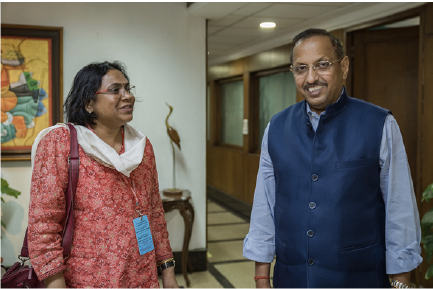Turning Energy Targets into Reality in India
Nothing changes in India like statistics. You keep feeling lousy, but the numbers tell you quite another story. Primafila India correspondent Swati Prasad takes a critical look at the country’s energy goals.

Text: Swati Prasad
Photos: Arush Mayank
Take the case of a friend who returned to Gurugram (or Gurgaon, as it was known until recently) this month, after living in Hong Kong for two years. She is upset that she has to pay double the rent for a smaller apartment in the same residential complex in Gurugram. And she finds her grocery costlier by at least 30-50 percent!
From Hong Kong though, India seemed to be growing at a healthy pace of over 7 percent per annum. It also appeared to be combatting corruption, building smart cities, increasing manufacturing, and generating surplus power.
Aggressive Energy Targets
Talking about power, India has set very aggressive targets — to supply ‘24X7 Power for All’ by 2019 and to push renewable energy in a big way.
While doing a story on India’s energy transition, I came across a lot of statistics. But the ground realities for Indians remains quite unchanged — even the big cities have power cuts, and several villages in India get power for only a few hours in a day.
Numbers seem to suggest that India is well on its way to meet its ‘24×7 Power for all’ target. India has a total of 600,000 villages, out of which only 4,983 villages today are un-electrified. The government has reportedly electrified 13,469 of the 18,452 un-electrified villages over the last two to three years.
Changing the Rules of the Game
But what does electrification mean? India’s definition of electrification is based on the following three conditions:
- Basic power infrastructure (such as a transformer and distribution lines) is provided in the inhabited locality.
- Electricity is provided to public places, such as schools, village council offices, healthcare centers, and community centers.
- The number of households electrified is at least 10 percent of the number of households in the village.
This definition, according to a source, is typical to India. The first threshold for electrification, according to him, should be that at least 50 percent of homes in a coverage area are electrified. And there should be no power cuts. As per an IndiaSpend report, while 96 percent of north Indian villages are electrified, only 69 percent homes have electricity.
To be fair, the Indian government is planning to change this atypical definition. The Union Minister of State (Independent Charge) for Power, Coal, New and Renewable Energy and Mines, Piyush Goyal, said in May 2017: “Every state in the country has joined the Power for All agreement…We have changed the rules of this game. Instead of counting 10% of households in the village to complete the electrification process, now the Government is focusing on providing power connections to each and every household of the village…”
We are just 12 months short of witnessing whether this target does indeed convert into reality. For, if it doesn’t, it will simply turn into another statistic that has no meaning for the common man.
Recent Posts
- Memorial Concerts “79 Roses” 05/12/2024
- Desire: The Carl Craig Story – Documentary, Music, Biography by Jean-Cosme Delaloye 29/04/2024
- Correspondent Jean-Cosme Delaloye also makes documentaries 14/02/2024
- American Express Previews: Gentlemen’s Sports 02/04/2019
- American Express Previews: Tennis & Golf 02/04/2019
